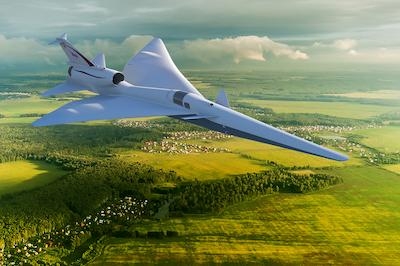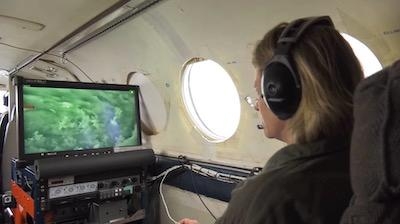Test Flown Aboard A Beechcraft King Air
NASA’s X-59 Quiet SuperSonic Technology, or QueSST, aircraft is poised to usher in a new dawn of supersonic commercial aviation through its culmination of unique technologies that lend themselves to quiet supersonic flight.

Enter the eXternal Visibility System (XVS).
Researchers at NASA’s Langley Research Center in Hampton, VA successfully completed in-flight testing of the XVS technology on NASA’s Beechcraft King Air UC-12B. The XVS will give X-59 pilots the confidence they need to safely maneuver the skies without a forward-facing window.
The XVS is a forward-facing camera and display system for the X-59 pilot that shows the airspace in front of him or her. During flight, the XVS uses its processing power with custom image processing software and camera systems, to create an augmented reality view of the X-59 pilot’s forward line-of-sight along with graphical flight data overlays.
“Our goal is to create an electronic means of vision for the X-59 pilot that provides performance and safety levels equivalent to or better than forward-facing windows,” said Randy Bailey, XVS subsystem lead.
The intention of the X-59 is to produce a barely perceivable “thump” on the ground while flying supersonic and provide data that could convince U.S. and international regulators to change the rules governing the speed of non-military aircraft over land.

The XVS allows for a slender and contoured aircraft nose that can more gently pierce supersonic airflow and yield smaller shock waves that can be better kept from coalescing into strong shock waves that can be heard on the ground.
Left unchecked, shockwaves generated from an aircraft flying at supersonic speeds can resemble a thunder-clap to those below.
The XVS technology is a tool that helps reduce a sonic boom to a sonic thump to people on the ground.
Actual XVS hardware intended for the X-59 was installed into the cabin of a Beechcraft King Air UC-12B aircraft and wired to a nose-mounted camera. In-flight test scenarios were flown to collect data on the pilot’s ability to see and maneuver around a traffic aircraft.
Direct side-by-side comparative evaluations, between sight through forward-facing windows and an XVS installed on the evaluation aircraft, measured the pilot’s ability to detect traffic, in this case, a smaller NASA aircraft. The test scenarios included extremely challenging offset nose-to-nose trajectories, one with crossing traffic at the same altitude, and another with the traffic aircraft climbing from below.
The key data for all the in-flight scenarios was a comparison of the time required to recognize the target aircraft by a pilot seated in the cockpit of the UC-12B looking through forward windows and a pilot seated in the cabin of the same UC-12B at the controls of the functional XVS mock-up. The two pilots had buttons that they pushed the moment they detected the small aircraft in the scenarios.

“I’ve continued to get more and more comfortable with the XVS through flight tests and our [X-59] flight simulators,” said Nils Larson, NASA X-59 test pilot.
Though an unlikely scenario, Larson said that “I can even land the airplane with the XVS turned off” by relying on his vision through the aircraft’s canopy, side windows, and data provided by the X-59’s avionics should the XVS malfunction.
The XVS is a combination of sensor, computing, and display technologies. It will display important graphical overlays on the cockpit’s main screen that will guide pilots to an airport, warn them of other aircraft near their flight path, and provide additional visual aids for airport approaches, takeoffs, and landings.
The electronic view XVS imagery is displayed on a 4K monitor in front of the pilot. It uses inputs from a 4K camera that is mounted on top of the nose pointing along what would be the pilot’s traditional forward-facing line-of-sight, and one retractable camera that can be deployed on the underside of the aircraft. Aircraft data, camera imagery, and pilot inputs will be fed to the XVS processor. During flight, the XVS uses its processing power with custom image processing software and camera systems, to create an augmented reality view of the X-59 pilot’s forward line-of-sight along with graphical flight data overlays.
The XVS represents a precursor to the future navigational architecture of supersonic commercial passenger and cargo aircraft. Slipstream aircraft designs previously rendered by futuristic conceptual artists are becoming reality. The long sleek nose of a quiet supersonic passenger jet needed to punch a hole into the airstream will be made possible by the XVS.
(Images provided with NASA feature)
 Airborne 04.16.24: RV Update, Affordable Flying Expo, Diamond Lil
Airborne 04.16.24: RV Update, Affordable Flying Expo, Diamond Lil ANN's Daily Aero-Term (04.20.24): Light Gun
ANN's Daily Aero-Term (04.20.24): Light Gun Aero-News: Quote of the Day (04.20.24)
Aero-News: Quote of the Day (04.20.24) Aero-News: Quote of the Day (04.21.24)
Aero-News: Quote of the Day (04.21.24) ANN's Daily Aero-Term (04.21.24): Aircraft Conflict
ANN's Daily Aero-Term (04.21.24): Aircraft Conflict




